► Premium sporting SUV triple test
► Levante vs X5 vs F-Pace comparison
► CAR’s triple test reveals the winner
There’s no hiding from SUV territory any more. The doubters who hurled abuse at Porsche for selling out with the first Cayenne are now revelling in the success of a company saved from the dustbin, and rivals who stood on sidelines awaiting disaster were sent scurrying in search of a clean sheet of paper. The rules have changed.
Maserati has spent the last two decades slowly stretching out its model range with the Ghibli and GranCabrio, but the Levante sees it entering entirely new territory.
Whether the traditional Maserati buyer is interested in an SUV is something of a moot point, as even at the more expensive end of the scale it’s the booming market, taking over 50% of luxury car sales. If anything the Levante represents the most likely route to Maserati ownership for new converts.
Not that the Levante is any kind of surprise. The Giugiaro-designed Maserati Kubang concept appeared at Detroit in 2003 and there’s still plenty of that car in the Levante, if sadly not the name.
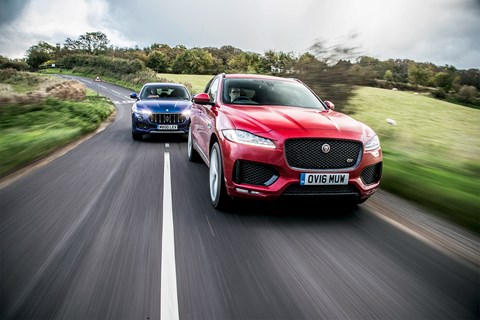
Based on the Ghibli platform with a 6mm stretch in the wheelbase, the Levante adds in air suspension to the Q4 four-wheel-drive system – not available on the Ghibli in the UK – and the Skyhook adaptive damping system, giving a claimed 50/50 weight distribution as well as a semblance of off-road ability. With the sole engine option of the 3.0-litre V6 diesel, the Levante starts from £54,335.
Possibly the only SUV mooted for longer than the Levante is Jaguar’s F-Pace. Another brand with a heritage of sporting cars daring to enter the hills of SUV land, Jaguar finally took the plunge with a car that carefully missed the toes of sister brand Land Rover.
Available with a greater range of engines including the F-type’s sparkling supercharged 3.0-litre petrol, here it comes in S trim with the 3.0-litre twin-turbocharged diesel offering up 296bhp, priced from £51,450.
Rounding off the trio is arguably the first SUV that didn’t handle like a wardrobe filled with blancmange: BMW’s X5. The Bavarians would rather you called it a Sports Activity Vehicle, but in truth the X5 has been popular due to its robust image, spacious cabin and road behaviour that still bears some semblance to the driving-machine ethos.
The xDrive 40d M Sport comes with a 309bhp version of the 3.0-litre straight-six diesel and starts from £56,925.
The CAR magazine triple test review
An early start for our east coast rendezvous means the Levante needs to be forgiving of a semi-functioning brain; thankfully the early signs are good. The cabin immediately feels special, helped by the better leather of the optional Luxury Pack and wood trim. It’s a step up rather than a climb, and once you’re aboard, the driving position mixes trad SUV and sports car; you sit naturally reclined but the view out is better than that of the hoi polloi.
Much of the cabin (below) is carried over from the Ghibli, including the single-plane auto gearshifter which makes getting reverse more of a headache than it should be. The infotainment system will look vaguely familiar if you’ve ever sat in a Grand Cherokee, but it works well enough if you opt for touch control rather than the counter intuitive i-Drive-like device.
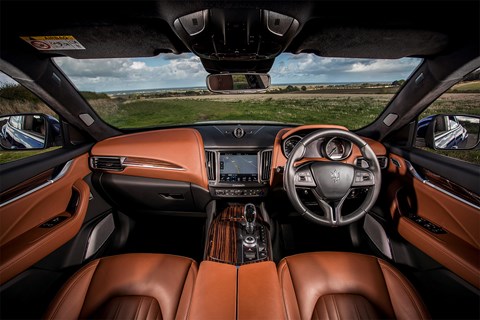
Your eyes won’t believe it but it’s the longest and widest car here as well as offering the longest wheelbase, which Maserati says delivers best-in-class interior space. It doesn’t feel quite as generous as that from the inside, chiefly because the design department delivered the tapered window line and sloping roof that eats into space a little, most obviously the rear headroom.
The boot is a decent shape and offers 580 litres of space – less than the other two – with the buttons for the electric tailgate handily placed at the base of the rear pillar.
Maserati Levante: how the V6 diesel performs
The Levante’s V6 fires with a multi-cylinder thrum outweighing any diesel-like chug, and at lower speeds at least there’s a surprisingly soft response from the throttle with the drive mode in Normal.
Push a little harder and the acceleration is there, with an encouraging snarl from the exhaust, and although it never really feels as fast as the headline figures suggest, the Levante rarely feels lacking in motivation. Punching the Sport button ramps up the responses from the steering, gearbox, engine and suspension, but offers the best compromise in the standard mode.
More encouraging is how the Ghibli’s sporting spirit has been successfully transferred into Levante. Around the straight-ahead position the steering initially feels a little sluggish, but the old-school hydraulic assistance comes alive once you have a few degrees of lock on.
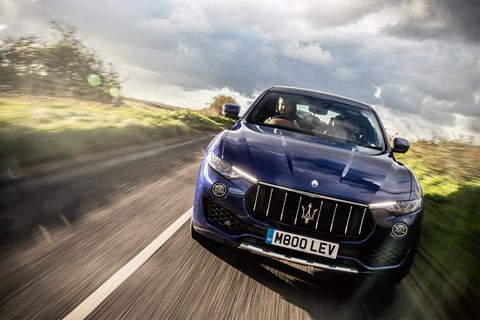
Tipped into a bend it shrugs off much of its SUV baggage and is keen to play, the 50/50 drive split means a little oversteer is available in the right conditions, and with the more aggressive of the two Sport modes engaged, roll is kept in check. Within the practical limits of its dimensions and physical mass the Levante is fun, and shouldn’t leave you pining too much for the Gran Turismo you had to replace with it.
It also appears to carry a similar cachet to the sportier Maseratis too. Whether it’s that imposing grille or iconic badge, the Levante turned heads wherever you go. In some ways it might be a familiar shape now given its long gestation period but it succeeds in blending the family baubles – grille, front-wing vents – with sufficient ground clearance and butchness to justify its 4×4 status.
Standard air suspension automatically drops the ride height at higher speeds and allows you to jack it up for off-road excursions, however unlikely they may be, especially if you’ve forked out the necessary £2,695 for 21-inch wheels.
The Jaguar F-Pace
Parked next to the Levante, the F-Pace is immediately modern and fresh, seemingly an escapee direct from a motor-show stand. Admittedly aided by the ludicrous 22-inch wheels (a £1600 option of debatable merit) it is the best-looking car here, the body stretched tightly over those massive rollers.
Shorn of its easily recognisable grille it might not be so clearly a member of the Jaguar family, but in a flash it makes the newer Maserati seem a fraction staid and the X5 look carbuncular.

If there is a core of Jaguar buyers who will privately admit to requiring additional room but are unwilling to openly declare a need for an SUV then the F-Pace is targeted right at them. Other than its physical height and increased ground clearance it is the least obvious car with a pretence of off-road ability, even if in reality it is more than capable of exceeding the owner’s expectations.
The almost anti-SUV tack continues inside, where occupants are greeted by a virtual carbon copy of the interior from the XE. The layout is refreshingly simple but lacks a little charm; the Jet/Light Oyster colour choice of the test car does it no favours, creating a gloomy cabin and making it hard to distinguish between leather elements and cheaper plastics.
The vaunted InControl Touch system isn’t always as slick as you’d like, but the major touch points are a pleasure to use – even if the wheel trades looks for feel.
Inside the Jag F-Pace cabin
You sit much higher in the F-Pace than in the Levante, although your view out isn’t necessarily any better. Those show-car looks result in the slimmest glazed area here, and from inside it feels less like a sports car and more like a fast first-floor flat.
Against the tape the F-Pace is accommodating even with the sunroof fitted, although up front the width of the transmission tunnel can make first-row occupants feel a little hemmed in and even more so in the back as the amount of light coming in is reduced still further.
The F-Pace’s boot is significantly up on the Levante with 650 litres available, even if the space itself is a little shallower. Only the Jag offers the Activity Key, which you can wear next to your iWatch and FitBit the next time you’re in desperate need of an exercise selfie.

On paper the F-Pace’s 3.0-litre diesel unit looks to have the advantage. It has an advantage of 25bhp over the Maserati and give away just 13bhp to the BMW, but more telling is the monstrous torque output – 516lb ft from 1750rpm puts it almost 10% ahead of its rivals, although out on the road the difference isn’t so clear-cut.
Throttle response is a little soft but once into the meat of the rev range acceleration is rapid, deceptively so thanks to the eight speeder’s smooth auto shifts. Less appealing is the noise delivered in the process, which isn’t completely dulled by the noise insulation.
Even in its standard settings the F-Pace offers the sportiest driving experience here. The ride – on 22-inch wheels at least – feels slightly biased in favour of cornering prowess, picking up more surface irregularities than the Levante, although things improve as speed rises. The upside is that the F-Pace feels remarkably light on its toes, keen to change direction and disguising its bulk if not so much its height.
The steering isn’t helped by the large wheels either; fine once a quarter turn of lock has been applied but curiously weighted until you get there. Regardless, for a back-road blast the Jaguar is the obvious pick of the bunch.
The Germanic SUV: BMW’s X5 on test
There was a time when the X5 was seen as a paragon of SUV handling, but the sheer number of rivals it now faces illustrates just how quickly the landscape has changed. In xDrive 40d M Sport guise there are still two rungs of M-related madness to go in the X5 hierarchy, but it is still clearly designed to have some semblance of sportiness as well as practicality.
One area in which the X5 more clearly lags behind the other two is appearance. Yes, it still holds an indomitable appeal for those keen to present an angry face to the world, but if you’re blessed with a keener sense of aesthetics then time has not been kind to BMW’s full-house SUV. While its rivals sacrifice some cabin space for beauty, the X5’s chunky, imposing glasshouse and boxy wheelarches contrive to make the optional 20-inch wheels look undersized and lost, which is almost a perverse achievement in itself.

The predictable flipside to this is that the BMW is the most practical proposition by some margin. From the driver’s seat the view out is spectacular, even with the chair in its lowest position, thanks to a big windscreen and deeper side windows, and the space on offer feels like something from a class above even though the X5 is only the tallest car here, not longest or widest.
It’s also the only one of the trio offering a third row of seats, with the second row splitting 60/40 for folding and sliding fore and aft. Throw in a two-piece tailgate and you can rub wings with the Range-Rover-set like nothing else here.
The cabin itself isn’t as pretty to look at as the Levante’s but in terms of functionality it’s hard to fault. Most of the materials are of a high standard and the clarity of the instruments and the controls is instantly reassuring.
The i-Drive system has now been boosted by the addition of a touchscreen facility, which makes address entry much quicker, but the i-Drive itself is so well honed these days that you could survive without ever leaving fingerprints on the 10.2-inch screen.
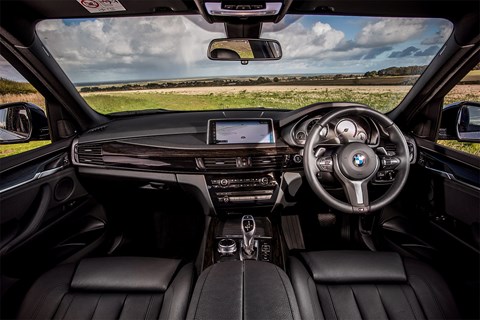
More of a surprise is the X5’s sheer glee in leaving its rivals choking on its dust. It gives away 301kg to the F-Pace as well as 51lb ft of torque yet it can beat it to 62mph by 0.3 of a second, the Levante by a whole second and is the only car here to perform the sprint in less than six.
The feel from the driver’s seat backs up the figures too, with the 3.0-litre unit overcoming initial wooliness to belt relentlessly forward accompanied by an unmistakable straight-six snarl. You can shift gears yourself but the eight-speed unit is best left to get on with it.
Ride, handling
Start to throw the X5 around however and its bulk can’t be disguised. Ultimately its behaviour is well within reasonable bounds and still fun to a degree but you’re left in no doubt that there’s a lot going on beneath the surface: the weight shifts around as the road flicks left and right, and the cornering attitude defaults to understeer almost without fail.
The steering, unfussy and acceptably sharp in normal driving, suddenly feels too disconnected and fails to give you enough info about what’s going on below. Best to exploit the flexible engine on the straights and go a little easier through the bends while still making pleasingly rapid progress.
On paper there is barely an ignored parking ticket between these three SUVs. Each one sports a 3.0-litre six-cylinder diesel and they are within £5k and 7mph of each other, but in execution there’s a clear dividing line between them. The BMW fits the traditional template of an SUV to the letter, being big in all directions inside and out, practical and easy to live with.
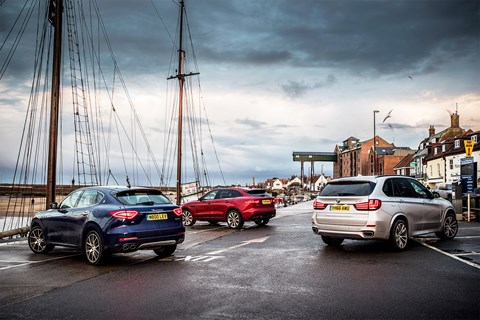
It also comes as standard with that imposing presence you’ll either love or hate, and for some buyers that will be enough. But the original premise is an SUV that can still satisfy on a good bit of road, and apart from the thunderous straight six the BMW falls a little short. It’s still an impressive car in many respects, but in this company it has to come third.
The remaining two have a more obvious sporting bent; in many ways the Jaguar is the complete opposite of the X5, feeling like an SUV for someone not fully prepared to give up on their XF saloon. It’s the most like a sports car here, with its dramatic looks, strong performance and keen chassis, but in hitting those targets it makes compromises elsewhere.
The cabin is disappointing, both in how it looks and the space on offer, while those huge 22-inch wheels don’t help the steering feel or the ride quality. It too is a strong package, but would suit someone prioritising style and the drive over genuine practicality.
Verdict
The Levante is far from perfect. It has the smallest boot, is the slowest car here and has the worst official fuel consumption figure, although it finished second in our test figures and 2mpg separated all three cars. After options it is also the most expensive car here, but it at least feels like it.
What the Levante does surprisingly well is tread a fine line of compromise between its two rivals. It’s more comfortable and offers more space inside than the Jaguar as well as being much more fun to drive than the BMW. The Levante looks and feels special inside and out, and successfully carries the weight of the Maserati name on its shoulders.
A successful argument can be made for all three of these cars as potential purchases, but it is the Maserati that most closely matches the tough brief of a sporting luxury SUV.
Click here for more comparison car tests